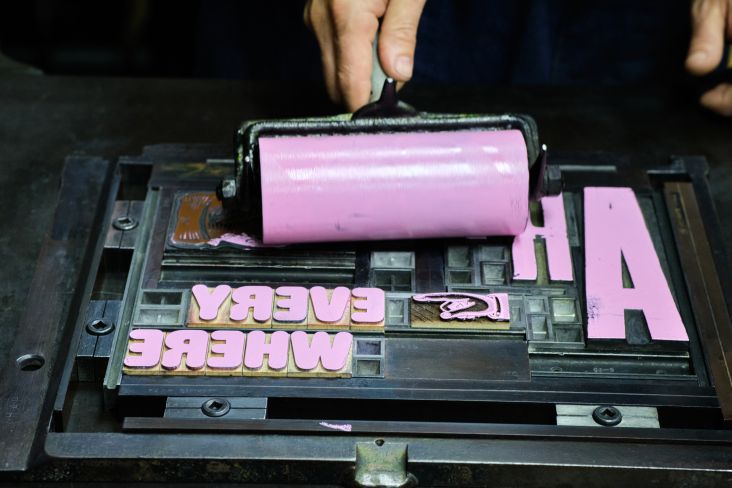How to pivot your freelance creative business in 2023
Freelancing not going as well as you'd hoped? Then it's time to pivot. We explain how to shift your work and clients in a new direction and give yourself the dream life and career you always hoped for.

Image licensed via Adobe Stock
So you've launched your freelance creative business: congratulations! But a few months in, things aren't going as well as you'd hoped. Maybe you're not generating the kind of money you were expecting. Or perhaps you're doing well, but the work is just not thrilling you or giving you the kind of creative fulfilment you were dreaming of. "If I wanted to feel like being on a conveyor belt," you think, "I might as well have stayed in my salaried job."
In which case, maybe it's time to pivot.
A pivot is a tried-and-tested strategy whereby you take a business that just isn't working and turn it in a completely different direction. Often, this involves taking one small aspect of it and making that the focus instead.
What a pivot looks like
For instance, fun fact: Instagram originally began as a niche social network for lovers of craft beer. One popular feature was the photo-sharing facility, which allowed members to swap shots of foaming pints every time they tried a new tipple. The founders quickly realised they were onto something and made that the entire app. It's now worth a staggering $102 billion.
Here's another example from the golden age of TV sitcoms. In the 1970s, ABC launched a show set in the 1950s called Happy Days. It was originally based around Richie Cunningham, a wholesome teen played by Ron Howard (who later became an Oscar-winning director). But several episodes in, everyone felt the show just wasn't working.
Suddenly, the producers discovered that one of the minor characters – an Italian-American greaser called Fonzie, played by Henry Winkler – was hugely popular. So they reorientated the entire show around him, and it became a massive hit. Two decades later, they performed the same trick, re-engineering Family Matters around the minor character of Steve Urkel. It became one of the highest-rated shows of the 1990s.
You get the idea. Maybe the thing you're doing isn't what you're supposed to be doing. But you don't have to start again from scratch; you just have to pivot.
So, how do you go about it?
The freelance guide to pivoting
If you're a freelance creative, pivoting is pretty straightforward. Either you pivot away from working with clients entirely (for instance, you might have developed a design or productivity tool in the course of your work and decide to focus on marketing and selling it to others). Or, you carry on working with clients but just get different ones. That might sound simple, but the difference it can make is profound.
Getting rid of clients should be pretty straightforward. You simply say goodbye to the clients you hate working with or who demand the kind of work you're sick of doing. However, in reality, this can feel rude and ungrateful. No one likes confrontation. Plus, it's just not in our nature to say goodbye to regular money.
If you can get past these psychological blocks, though, it can transform your life and business. So it's well worth doing, and it's worth doing methodically. Here are our tips on how to pivot away from your least valued freelance clients.
1. Set small, achievable goals
Not confident enough to drop a bunch of clients at once? Then don't. Instead, make a plan with small, achievable goals to shift away from what's making you miserable. These might be as simple as just refreshing your website or expanding your network to open up new possibilities.
Whatever these small goals are, they should work towards a main, overriding one: to find new sources of income that will let you shift away from the stuff you hate and towards the stuff you dream of. With that in mind, make marketing a weekly focus and actively seek out new clients.
This small move to making a positive shift will give you a boost as you realise that, no, you can't wave a magic wand and change everything overnight… but you can make a plan. And a plan feels like you're gaining back control.
2. Review your clients
Reviews are a great halfway house between ditching a client altogether and just slogging on in misery. Start small by requesting an annual review with one client to test the water.
Say it's something you're introducing now to improve your business and ensure you're doing your best for all clients. That makes it sound like you're thinking of them rather than yourself! But actually, it's a chance to hit reset on the relationship and iron out any issues.
For instance, if you're on a retainer and work has crept over the allocated paid time, a review gives you the opportunity to raise the issue confidently and positively. You might, say, produce your timesheet and say something like: "Well, we originally budgeted for X days per month but ended up doing extra X hours. So given the account has grown, we'd love to ensure we grow with you and recommend a new retainer of X to cover those extra hours..."
But what if the client says no? Well, actually, this is a win-win because you've highlighted that you're doing overtime for free, and therefore they have a choice. They either have to slash their expectations of the work you'll deliver and go back to the original budget or accept the additional cost.
If all goes well, try this annual review with another client. And then another. Soon, you'll have either reset all your relationships to your advantage or realised that some clients just aren't worth the candle. Either way, you'll have moved things forward.
3. Rework your portfolio
It's a common problem and somewhat of a vicious circle. You're finding the type of work you're doing a drag and want to pivot to something else. But you haven't yet got the work in your portfolio to show you're capable of it. So why should anyone trust you with this sort of commission?
A popular way around this is to do side projects to showcase your expertise. Also, rewrite your headline statement on your About page and social media bios to make things clear. Simply writing, "I specialise in event photography," for example, will go a long way to convincing people that you are.
Also, seek inspiration from your peers and investigate other freelancers who seem to be doing well. Don't outright copy their efforts, obviously, but be inspired by what they're doing.
This might seem like an obvious point, but we're constantly surprised by how few freelance creatives really investigate the competition. In other areas of business, people do it constantly, sometimes to the point of obsession!
4. Get a coach or mentor
The best way to get better at anything is to get an expert to guide you. If you want to improve your piano playing, you would hire a piano tutor. If you want to improve your golf, paying for an hour's guidance with a professional will raise your game like nothing else. And in freelancing, too, guidance from those who've been there, done that, can be utterly invaluable.
We've found a surprising number of top-level creatives willing to mentor others, so check out those you admire the most and send them an email, simply saying, 'I'd love you to be my mentor'. The worst they can say is no.
Meanwhile, if it's more business advice or life coaching you're after, you'll have to pay, but it'll usually more than pay for itself in the long term. So stop moaning about work with your partner, family or housemates, and hire a professional who's better placed to guide you in business.
5. Be prepared to walk away
Ultimately, all of this comes down to sticking to your guns.
We creatives are natural people-pleasers, so doing this in practice can be tough. But really, it's not that hard. Just stand firm. Remember, you're in charge of your business, not the client. And be prepared to negotiate and walk away if things don't work out.
In other words, you need to set boundaries; otherwise, clients will walk over you – sometimes without even realising they're doing so.
Instead, control the conversation, decide in advance of negotiations what you actually want out of them, and focus on the end goal. That way, you'll soon have a creative freelance business that compensates you properly, fulfils you creatively, and provides the kind of work-life balance you need.




 by Tüpokompanii](https://www.creativeboom.com/upload/articles/58/58684538770fb5b428dc1882f7a732f153500153_732.jpg)


 using <a href="https://www.ohnotype.co/fonts/obviously" target="_blank">Obviously</a> by Oh No Type Co., Art Director, Brand & Creative—Spotify](https://www.creativeboom.com/upload/articles/6e/6ed31eddc26fa563f213fc76d6993dab9231ffe4_732.jpg)
















